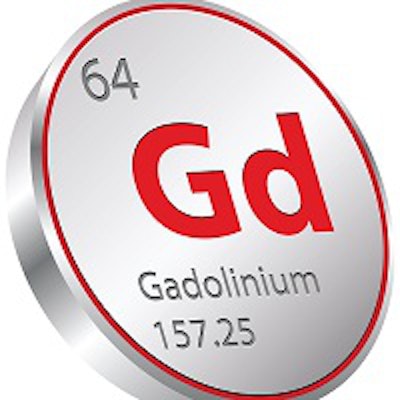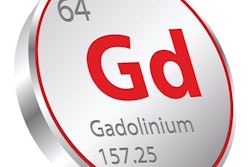
Does radiology need a better nomenclature for the problem of exposure to gadolinium from contrast MRI exams? In a recent paper in the American Journal of Roentgenology, researchers propose new terms to describe the aftereffects of gadolinium exposure that can affect patients but which fall short of nephrogenic systemic fibrosis (NSF).
They are proposing the term "gadolinium storage condition" for patients who have normal renal function but also proven remnants of gadolinium in their brain tissue or bone. Meanwhile, "gadolinium deposition disease" would be used to describe patients with adequate renal function who still develop persistent and sometimes painful symptoms a few hours or weeks after receiving gadolinium contrast (AJR, May 25, 2016).
In cases of gadolinium deposition disease, the otherwise healthy patients "have real pain," said lead author Dr. Richard Semelka, director of MR services and a professor of radiology at the University of North Carolina at Chapel Hill.
"The most obvious is pain in the lower arms and lower legs," he said. "I have had people describe it as pain like a knife ... through their arms. It isn't like the wrist is just sore."
Issues with gadolinium contrast
The possible near- and long-term side effects of gadolinium contrast came to the forefront almost 10 years ago, when patients with insufficient renal function began to develop nephrogenic systemic fibrosis, a painful and often-debilitating disease. The U.S. Food and Drug Administration (FDA) in 2007 mandated that gadolinium contrast manufacturers add black box warnings to their products regarding the risk of NSF for these patients.
 Dr. Richard Semelka from the University of North Carolina.
Dr. Richard Semelka from the University of North Carolina.
No new cases of NSF have been reported since 2009, which the authors attributed to the use of more stable gadolinium-based contrast agents (GBCAs) and limitations on the use of gadolinium contrast in patients with renal failure. Confidence in the safety of gadolinium contrast returned over the next five years, Semelka and colleagues wrote.
But the debate over the safety of GBCAs took another turn in 2014 and 2015, when several researchers found traces of gadolinium in the brain tissue of people with normal renal function, many years after they underwent contrast-enhanced MRI scans. These findings prompted the FDA to act again last August by announcing an investigation into the safety of gadolinium contrast.
This past April, a new review of literature on gadolinium contrast found a "significant gap in knowledge" of the health effects of the heavy metal's accumulation in tissue, prompting researchers to call for new clinical studies and the development of a drug to remove retained gadolinium from the body.
Unknown significance
In the current AJR paper, the authors suggest that the clinical significance of gadolinium deposition in tissue remains unknown. In a previous study, Dr. Lauren Burke, Semelka, and colleagues decided to investigate whether and how patients exhibit symptoms after gadolinium exposure.
"For me, it was interesting that no one seemed to look into whether patients were symptomatic," Semelka told AuntMinnie.com.
To that end, the researchers created an anonymous online survey that asked nine questions of patients with normal renal function who believe they developed gadolinium toxicity after a GBCA MRI scan. The results were published online May 19 in Magnetic Resonance Imaging.
Fifty patients participated in the survey and provided information on several issues:
- The number of doses and types of contrast agent received
- Any subsequent symptoms experienced
- How soon after GBCA administration the symptoms occurred
- Whether they thought the contrast agent contributed to their adverse condition
The 50 respondents received an average of 4.2 doses of gadolinium contrast intravenously (range: 1-23 doses), and at least 8% of the individuals were exposed to several different gadolinium-based contrast agents.
All 50 people attributed their maladies to GBCA exposure, with 33 (66%) saying that their symptoms appeared immediately after they received the contrast agent.
The most common side effects were bone and joint pain (78%) and head and neck issues (78%), which included headache, vision change, and hearing change. Other symptoms occurred with less frequency.
| Symptoms reported from gadolinium contrast | |
| Self-reported symptoms | No. of respondents |
| Bone/joint pain | 38 (78%) |
| Head/neck pain | 38 (78%) |
| Skin changes | 29 (59%) |
| Nausea, vomiting, diarrhea | 23 (47%) |
| Chest, difficulty breathing | 21 (43%) |
| General whole-body symptoms | 30 (31%) |
The surprising thing about the study is how many individuals with normal renal function exhibited symptoms of gadolinium exposure, Semelka said.
"The interesting thing is that many radiologists and others are shocked and surprised by this finding, but, indeed, patients with normal renal function have described being very symptomatic from gadolinium exposure," Semelka said. "My reaction is: Why shouldn't patients with normal renal function get toxic symptoms from gadolinium?"
The authors noted several limitations of the survey due to the self-reporting approach and potential selection bias from the respondents; however, Semelka said the results are not surprising.
"The thing that seemed obvious and predictable is that many patients had NSF-like disease and also, not surprisingly, less severe than NSF," he added. "So, we were not surprised that they would have NSF-like symptoms."
'Brain fog'
Semelka believes that the survey's findings -- that there is evidence of symptoms of gadolinium exposure that fall short of NSF -- support the rationale for a new terminology, which he and his co-authors introduced in AJR. Classifying patients can also help make radiologists and clinicians more cognizant of the potential side effects of GBCA administration.
The researchers proposed the term gadolinium storage condition to describe patients who retain gadolinium in tissues such as bone matrix or the brain. Semelka et al note that the least stable GBCAs seem to be most likely to result in the condition, while the most stable agents either don't cause it or cause it at very low levels.
The second term, gadolinium deposition disease, refers to patients who develop persistent symptoms that arise hours to two months after GBCA administration. The authors noted that symptoms of gadolinium deposition disease are similar but not identical to those of NSF.
Unlike people who develop NSF, many of these otherwise healthy individuals also complained of "mental confusion, which a number of them called 'brain fog,' " Semelka said.
To guard against gadolinium deposition disease, radiologists should watch for the onset of NSF-like symptoms in patients with normal renal function, according to the authors. They also recommended a 24-hour urine test for gadolinium, 30 days or more after a patient's most recent gadolinium administration.
"Early recognition will facilitate early treatment of the disease before it becomes more chronic and likely less responsive to therapy," the authors wrote.
As for future research, the authors suggested that genetic testing may help determine which patients are likely to develop NSF, gadolinium storage condition, or gadolinium deposition disease, but conceded that such a test is not in the near future. Early detection and treatment are the focus of management, they concluded.


.fFmgij6Hin.png?auto=compress%2Cformat&fit=crop&h=100&q=70&w=100)





.fFmgij6Hin.png?auto=compress%2Cformat&fit=crop&h=167&q=70&w=250)











